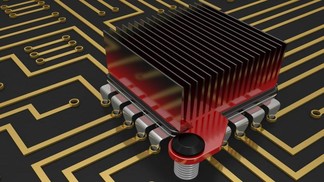Nov 27 2012
EPFL is celebrating its 1000th invention : Kandou. Or how mathematics came to the rescue of electronics, enabling processors that are smaller, faster and more energy-saving.
 © 2012 EPFL
© 2012 EPFL
150 billion kWh per year. That’s the worldwide electricity consumption of computers, which translates into a monthly bill of several billion dollars. Reducing this consumption, even by only a few percent, therefore represents an important economic and ecological factor. This is the objective of Kandou, the 1000th invention of EPFL.
The Service of Industrial Relations (SRI), responsible for the transfer of technologies to industry, has in fact just received its 1000th invention for evaluation. The first one managed by the SRI concerned the solar cells of Professor Grätzel, winner of the Millenium Technology Prize in 2010. “EPFL protects promising inventions above all with the goal of being useful to society” explains Gabriel Clerc, the person responsible at SRI.
Kandou, invented by Harm Cronie and Amin Shokrollahi of the Laboratoire d’algorithme de l’EPFL, enables processors to communicate more rapidly – while using less energy – with their peripherals (memory, printers, monitors). This represents a small revolution in the world of computing, with the solution coming from . . . mathematics!
Most electronic appliances are nowadays equipped with ultra-rapid processors. These communicate with other processors or with other peripherals by using electronic buses, sort of “information highways”. The problem is that these devices, made up of tiny wires, interfere with each other, resulting in the signal transmission being parasited and limiting full use of the processors’ capacity. While the intensity of the signal can be amplified, these disturbances increase proportionally, like two couples chatting in a restaurant: their talking interferes with their neighbours, and their speech is barely audible. Chatting more loudly doesn’t help at all, as everyone has to increase the volume. You could build a wall between the couples, but that would take up space and would still not suppress the interference.
Over the last 10 years, the buses have been modified by adopting differential signalling. The information is transmitted by pairs of wires. On one of them, the message is transmitted in “positive” and the other in “negative”. Each pair of wires received more or less the same interference from the environment. By substracting the “positive” information from the “negative” information, the disturbances are cancelled out, while the intensity of the signal is doubled. This solution is effective, but requires twice as many wires, which isn’t always feasible. So the amount of energy per wire has to be increased to obtain the desired speed. The result – though better than the first solution – is still not perfect.
In the near future, a new technology should be implanted in electronic systems – Kandou, which uses mathematics to solve these problems. A bus based on the Kandou system codes the signal using an astute algorithm, then transfers it over all the wires simultaneously. A decoder at the destination point allows the recovery of the data. Let’s return to the analogy of the two couples: instead of speaking the same language, one of the couples speaks French, and the other sign-language. In each couple, the two people understand each other perfectly. Kandou uses a similar system, thus eliminating interference and background noise.
This invention brings multiple benefits. On the one hand, fewer wires are required, and so devices can be smaller: on the other hand, the speed of transmission of the signal can be considerably increased. Lastly, the electric intensity in the wires can be significantly reduced, which enables energy savings. Depending on the applications, different benefits – sometimes combined – will be emphasized. For example, in mobile phones, manufacturers are looking to reduce energy consumption in order to increase autonomy. In a computer, the objective is to increase the speed of data transfer and therefore overall performance. The number of wires in DSL lines or ocean-crossing cables could also be reduced.
The largest multinationals are already interested in Kandou, which could equip most of our electronic systems within a few years.